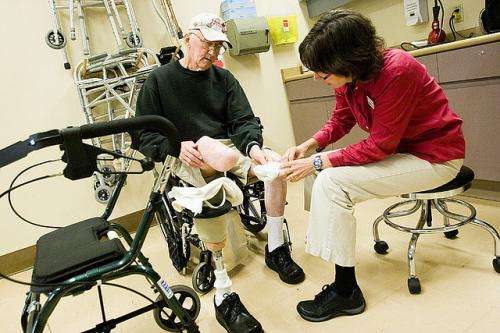Amputees found to shy away from prosthetics

Local researchers have predicted several points in time in which lower-limb amputees may stop using their prostheses after they are discharged from rehab.
Fiona Stanley Hospital senior physiotherapist for Amputee Rehabilitation Caroline Roffman conducted the research with Royal Perth Hospital scientists to determine the best treatment options for patients with lower limb amputation.
"When patients undergo rehabilitation following an amputation, it's a protracted process," Ms Roffman says.
"Patients have pre-operative education, then after surgery they do specialised exercises and learn to move without a prosthesis.
"Once their stump has healed some patients will go on to have a prosthetic limb made and learn to walk over several months."
She assessed a variety of factors patients need to achieve during their rehabilitation process in order to feel comfortable to successfully utilise their prosthetic limb.
"I collected data then interviewed patients who had been through the whole rehabilitation process to determine who used their prosthesis and who stopped using their prosthesis, and for what reasons," Ms Roffman says.
They conducted a retrospective study involving 135 participants (predominantly males aged over 50 years) and a prospective study involving 66 participants to understand what factors contributed to patients no longer using their prosthetic limb.
The researchers determined rules for predicting prosthetic use at four, six, eight and twelve months after participants were discharged from rehabilitation.
Four-month mark most likely period of non-use
They found that at the four month mark if four out of five predictors were present the probability of participants not using their prosthetic limbs increased from 12 per cent to 86 per cent.
"The significant factors common to all the time frames were amputation through or above the knee and using a mobility aid at discharge," Ms Roffman says.
"The reason these factors were important is because it takes more energy and skill to walk with a prosthesis that has a knee joint."
Patients were also less likely to use their prosthetic limbs if they couldn't walk independently outdoors on concrete, had many medical comorbidities, they didn't have type 2 diabetes and there had been a delay to gait retraining.
"Diabetic patients were more likely to use their prosthesis," she says.
"One theory is the prosthetic leg may be functionally better than the leg they had before surgery however further research is required.
"Our research highlights the importance of rehabilitation at an appropriate intensity early after amputation," she says.
Ms Roffman hopes the research will help shape the model of care for amputee rehabilitation.
More information: Caroline E Roffman, John Buchanan, Garry T Allison, Predictors of non-use of prostheses by people with lower limb amputation after discharge from rehabilitation: development and validation of clinical prediction rules, Journal of Physiotherapy, Volume 60, Issue 4, December 2014, Pages 224-231, ISSN 1836-9553, dx.doi.org/10.1016/j.jphys.2014.09.003.


















